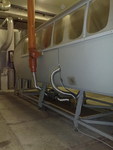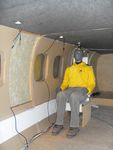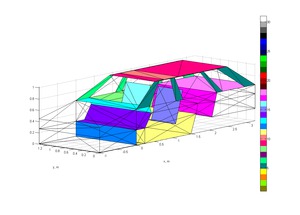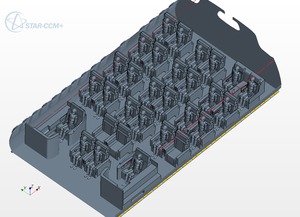Laboratory of thermal comfort
 The laboratory or its team deals with the research and development in the field of air-conditioning systems that are
employed to adjust indoor environment quality of vehicle cabins or buildings; it also includes testing the system
effect on thermal comfort. The main demand today is development and design of such air-conditioning systems that
provide optimum thermal comfort at the lowest energy and operating costs.
The laboratory or its team deals with the research and development in the field of air-conditioning systems that are
employed to adjust indoor environment quality of vehicle cabins or buildings; it also includes testing the system
effect on thermal comfort. The main demand today is development and design of such air-conditioning systems that
provide optimum thermal comfort at the lowest energy and operating costs.
In order to create high quality and comfort environment inside a vehicle cabin, it is, first of all, necessary to provide cooling/heating and sufficient ventilation rate. Engineering systems that provide this functionality are acronymically called HVAC systems which comes from heating, ventilation and air-conditioning systems. Features of such systems and their impact on the quality of ventilation, air-conditioning and thermal comfort are typically tested by means of either simulations or measurement involving real models. For simulations of systems and indoor environment of buildings and cabins, the department employs CFD and 1D simulation tools. The tests conducted on real models are carried out at the department facilities equipped to measure parameters of indoor environment with the use of a thermal manikin, a small size airplane cabin mock-up and a climate chamber for functional testing of systems under conditions that correspond to real operation.
What we deal with:
- Simulations of vehicle cabin environment
- Thermal comfort assessment
- Calculation and simulation of cabin thermal balance
- Models of human thermal comfort
- Assessment of thermophysical properties of clothing
- Ventilation quality assessment
- Air duct optimisation
- Simulations of building indoor environment
Instrumentation:
Newton thermal manikin - The thermal manikin is average in its human body features and is
employed when assessing thermal comfort both indoors and outdoors, and evaluating thermal insulation capacity of
clothing or other equipment associated with sport or work.

Portable system for measurement in car environment - The measuring system is capable of real-time mobile measurement in a car cabin environment, outdoor environment parameters measurement as well as measurement of car location, elevation, orientation and speed. The data measured are continuously recorded so to be assessed on the environment quality in the measured car cabin under real operation conditions.

Experimental facility:
- The cabin dimensions are 1.6 × 1.4 × 7.4 m, volume 13 m3, the air-conditioning unit is capable of delivering between 100 and 500 m3/h of air flow rate at temperatures between 10 and 40 °C. The measuring system is based on ADAM 4000 modules and TESTO measuring instruments. A LabView 8.0 designed interface provides data acquisition capability, which is easy to adjust for particular conditions and/or ventilation system tested.


Climate chamber - It is intended for complex testing of cars or vehicle cabins under defined climate conditions. It simulates the surrounding environment by imposing synthetic global radiation along with climatic load both in alternating cycles, combining wet or dry cold according to the regional climate thus enabling outdoor atmosphere effect at a realist acuity corresponding to experience.

- The laboratory is designed and equipped for a wide spectrum of tasks associated with fluid flow investigation with the use of optical measuring methods. It is particularly suited for testing ventilation equipment of rooms and/or vehicle cabins.

Software models developed:
Cabin heat load model - The model aims at prediction of heat load and parameters of car cabin indoor environment under real operating conditions. Its current version is derived from a particular car make by employing its geometry and material composition. Based on boundary conditions: ventilation parameters (flow rate, temperature and relative humidity of the supplied air), driving parameters ( speed, car orientation to sun) and number of people in the car, environmental parameters in the car such as air temperature and relative humidity can be predicted. At the same time, it is possible for the cabin heat load to be calculated hence the need for heating/cooling. The previous model was created within Dymola environment (Modelica language), the newer one relies on Matlab.

Thermal comfort model of a human being - The model is intended for predictions of thermal comfort in inhomogenous environments (e.g. vehicle cabin). Based on parameters of the surroundings (temperature, mean radiant temperature, relative humidity, air speed) and a human being (clothing, activity), it predicts surface temperature and respective thermal sensation. The model is derived from Tanabe's physiological model of human being and Zhang's thermal comfort model. It was created within Dymola environment (Modelica language).

Project solved:
Josef Bozek Competence Centre for Automotive Industry
- Identification code: TE01020020
- Solution period: 2012-2017
- Involvment: WP 22 - Human Centered Cabin Design
Complex modelling of the interaction between human being and the environment of a vehicle cabin or
residential spaces, and respective design tools
- Identification code: FSI-S-11-6
- Solution period: 2011-2013
- Involvement: solution in the field of air distribution systems design tools and development
Projects completed:
iSPACE - inovative Sytems for Personalised Aircratf Cabin Environment (2010-2012)
http://www.ispace-project.eu/
Brno University of Technology role in the project::
- Methodology development for selection of suitable technology concepts of individualised microclimate – project task WT 2.3 - Selection of Concepts for Individualised Cabin Environment
- CFD model of personalised ventilation outlets and a case study of their effect/performance on thermal comfort – project task WT 2.2 - Simulation and Parameter Study
- Detailed CFD model of the entire cabin including all technology tested, evaluation of simulations, thermal comfort and results validation against measurement – project tasks WT 4.1 - Refinement of Simulation of Individualised Cabin Environment, WT 4.4 - Validation of Simulation of Individualised Cabin Environment


Airspace research centre - CLKV (2005-2011)
-
Within the frame of research task A6 – Prediction of indoor environment in aircraft cabins, the issue of predictions indoor environment in a small aircraft cabin was solved with the use of CFD simulations and 1D simulation programmes. The assessment methodology of thermal comfort that employed comfort zone charts along with a virtual passive manikin was completely implemented. Close attention was paid to effects of the air duct geometry and air distribution strategy on the passengers thermal comfort and ventilation quality.
Junior project – Development of a 1D model of a car cabin for indoor environment parameters prediction (2011)
-
The project focused on pilot development of a 1D car cabin model for prediction of indoor environment parameters as well as data acquisition for validation of simulation results. The data were obtained during real car road tests (traffic type: city, countryside, motorway).
We cooperate with:
Škoda auto a.s. TKP - Vývoj topení a klimatizace (Heating and air-conditioning system development) V. Klementa 869 | 293 60 Mladá Boleslav | Czech Republic Team leader: Pravoslav Nedoma Volkswagen Corporate Research Vehicle Technology CAE-Methods D-38436 Wolfsburg| Germany Team leader: Dr. Henry P. Bensler
Indoor Environment Department Group Indoor Climate Systems Fraunhofer Institute for Building Physics IBP Holzkirchen Branch Fraunhoferstraße 10 | D-83626 Valley | Germany Team leader: Dipl.-Ing. Gunnar Grün
Contact:
Ing. Jan Fišer, Ph.D., phone : +420 54114 3242, email: fiser@fme vutbr
vutbr cz
Ing. Jan Pokorný, Ph.D., phone : +420 54114 3264, email: pokorny.j@fme
cz
Ing. Jan Pokorný, Ph.D., phone : +420 54114 3264, email: pokorny.j@fme vutbr
vutbr cz
cz



